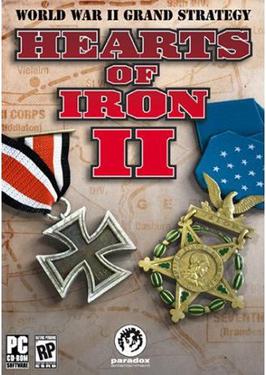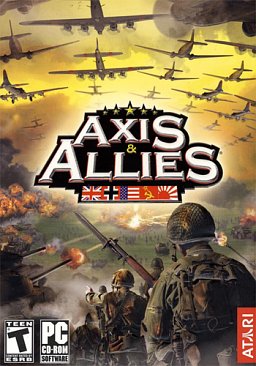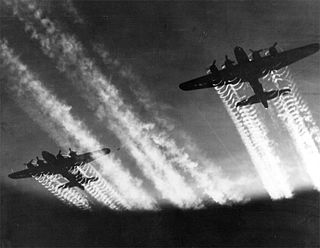
Axis & Allies is a series of World War II strategy board games. The first version was initially published in 1981 and a second edition known colloquially as Axis & Allies: Classic was published in 1984. Played on a board depicting a Spring 1942 political map of Earth divided by territories, players take the role of one or more of the five major belligerents of World War II: the Axis powers of Germany and Japan; and the Allied powers of the Soviet Union, the United Kingdom, and the United States. Turns rotate among these belligerents, who control armies of playing pieces with which they attempt to capture enemy territories, with results determined by dice rolls. The object of the game is to win the war by capturing enough critical territories to gain the advantage over the enemy.
This is a list of aviation-related events from 1941:
Axis & Allies: Pacific is a strategy board game produced by Hasbro under the Avalon Hill name brand. Released on July 31, 2001 and designed by Larry Harris, the designer of the original Axis & Allies game, Axis & Allies: Pacific allows its players to recreate the Pacific Theater of World War II.

Hearts of Iron II is a grand strategy computer war game for Microsoft Windows based upon its predecessor, Hearts of Iron, which was developed by Paradox Development Studio and published by Paradox Interactive.
World in Flames is a grand strategy game on the Second World War which was first released in 1985 by the Australian Design Group, and currently holds the title of the world's largest commercially available board game. It was designed by Harry Rowland and is currently in its eighth edition, World in Flames - Collector's Edition. Each new edition features changes to the rules, maps and counters.

Pacific General is a computer wargame depicting famous battles of the World War II Pacific campaigns. It was published by Strategic Simulations in 1997 using the same game engine of the earlier and successful Panzer General for Windows 95. It was re-released on GOG.com in May 2015.
The main opposing forces in the Polish September Campaign, which marked the beginning of the Second World War in Europe, consisted of Germany on one side, and Poland on the other. The Soviet Union also invaded Poland from the east during the campaign.

Axis & Allies is a real-time strategy World War II video game developed by TimeGate Studios and published by Atari for Microsoft Windows. The game was released on November 2, 2004. It is based on the board game series Axis & Allies from Milton Bradley and also on TimeGate's Kohan series. Set in the years after Japan and the United States entered into the war, the game allows the player to act as a World War II commander to build military forces to fight against other generals, using military units and technologies from the war. The player is able to rewrite and recreate the history of World War II.

Industrial warfare is a period in the history of warfare ranging roughly from the early 19th century and the start of the Industrial Revolution to the beginning of the Atomic Age, which saw the rise of nation-states, capable of creating and equipping large armies, navies, and air forces, through the process of industrialization.

The military history of the United States during World War II covers the nation's role as one of the major Allies in their victory over the Axis Powers. The United States is generally considered to have entered the conflict with the 7 December 1941 surprise attack on Pearl Harbor by the Empire of Japan and exited it with the 2 September 1945 surrender of Japan. During the first two years of World War II, the US maintained formal neutrality, which was officially announced in the Quarantine Speech delivered by US President Franklin D. Roosevelt in 1937. While officially neutral, the US supplied Britain, the Soviet Union, and China with war materiel through the Lend-Lease Act signed into law on 11 March 1941, and deployed the US military to replace the British forces stationed in Iceland. Following the 4 September 1941 Greer incident involving a German submarine, Roosevelt publicly confirmed a "shoot on sight" order on 11 September, effectively declaring naval war on Germany and Italy in the Battle of the Atlantic. In the Pacific Theater, there was unofficial early US combat activity such as the Flying Tigers.

Axis & Allies is a 1998 computer wargame closely based on the Axis and Allies: Classic board game.
Axis & Allies: Battle of the Bulge is a board game which depicts the Battle of the Bulge, the "last-ditch" offensive of World War II by Nazi Germany. It is similar to Axis & Allies: D-Day in that the game is played on a tactical rather than strategic level, although the gameplay is radically different from D-Day or any other previous Axis and Allies game. It is designed by Larry Harris, and published by Avalon Hill.

P.T.O. IV, released as Teitoku no Ketsudan IV (提督の決断IV) in Japan, is a World War II-themed strategy for the PlayStation 2 and PC produced by Koei. It focuses on naval combat in the maritime theaters of World War II, encompassing the Pacific Ocean, Mediterranean Sea, Atlantic Ocean, and Indian Ocean, with the option of playing as one of four major maritime powers of the time: Germany, Japan, the United Kingdom, or the United States. P.T.O. IV is the latest game in Koei's P.T.O. series.

P.T.O., released as Teitoku no Ketsudan (提督の決断) in Japan, is a console strategy video game released by Koei. It was originally released for the PC-9801 in 1989 and had been ported to various platforms, such as the X68000, FM Towns, PC-8801 (1990), MSX2 (1991), Sega Genesis and the Super NES. Players could assume one side of the Pacific Theater of Operations during World War II, acting as naval commander, organizing fleets, building new ships, appropriating supplies and fuel, and even engaging in diplomacy with other countries. The player can choose one of several World War Two battles to simulate, or could control the entire Pacific campaign well before the Japanese attack on Pearl Harbor.
The article summarizes casualties in different theatres of World War II in Europe and North Africa. Only the military losses and civilian losses directly associated with hostilities are included into the article. The actions of the Axis' and Allied military or civilian authorities that fit the definition of genocide, or war crimes are left beyond the scope of the present article.

Axis & Allies: Pacific 1940 is a board game created by Larry Harris and published by Avalon Hill as part of the Axis & Allies family of games. It is considered to be a revision of Harris' earlier game, Axis & Allies: Pacific. Among the major changes from Pacific was the incorporation of newer rules from newer Axis & Allies revisions, as well as features exclusive to this game.

Axis & Allies: Europe 1940 is a 2010 board wargame simulating the European Theatre of World War II at the strategic level.

Axis & Allies: World War I 1914 is a war and strategy board wargame in the Axis and Allies series created by Larry Harris and published by Avalon Hill. Unlike the other games in the Axis and Allies series, it focuses on World War I, specifically the European, African, and Near East theaters.
This article discusses aircraft carrier operations during World War II.
World War II was the first war where naval aviation took a major part in the hostilities. Aircraft carriers were used from the start of the war in Europe looking for German merchant raiders and escorting convoys. Offensive operations began with the Norwegian campaign where British carriers supported the fighting on land.













